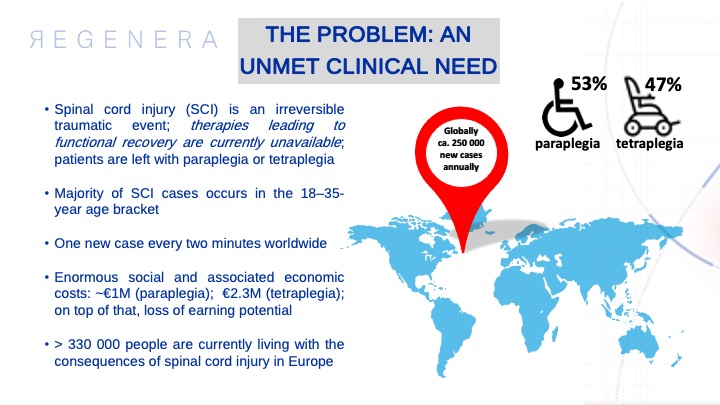Making paralysis a thing of the past!

Spinal cord injury (SCI) is a damage to the spinal cord that permanently impairs its function. SCI is divided into traumatic and non-traumatic forms. Traumatic SCI occurs when an external physical impact (for example, a car accident, sports-related injury, a fall, etc) acutely damages the spinal cord, whereas non-traumatic SCI is caused by disease processes, such as tumour, infection or a herniated disc.
Worldwide, SCI has a considerable impact in terms of mortality and morbidity and considering an annual incidence of ca. 250’000 new cases worldwide (WHO estimates). SCI represents a disproportionate burden for healthcare systems due to the expensive and complex medical support required foreach single patients with SCI, not only in the acute phase, but for the rest of the patient’s life. SCI is a leading cause of disability especially among younger (mostly male) people, with a high impact on years lived with disability. Additional grave economic consequences arise because patients drop out of the work force repeatedly, if not permanently. This loss in productivity affects whole families and hurts national economies.
Mortality risk increases with injury level and severity and strongly correlates with availability of timely, quality medical care; estimates for acute in-patient mortality range from 4% to 17%. Although survival of patients with traumatic SCI has improved over time, their mortality rates exceed those of age-matched controls. Post-injury mortality risk is highest in the first-year post-injury but remains elevated compared to the general population, and so people with SCI are 2-5 times more likely to die prematurely than people without SCI; annual mortality rates for SCI victims remain persistently high, with 3.8% of patients dying in the first year after injury, 1.6% in the second year and then 1.2% for every year thereafter.
In short, SCI has devastating physical, social and professional consequences for patients and their families; a loss of independence and persistently increased lifelong mortality rates are the hallmarks of SCI.
In light of the grim outlook for so many SCI cases, the acute phase of SCI is the current therapeutic frontier. It offers considerable plasticity potential of neural regeneration for those approaches that can harness it. Even small neural tissue gains might bring back bladder/bowel control and more, thus creating huge increases in quality of life and rehabilitation. This makes repairing damaged neural tissue an urgent unmet clinical need.
Indeed, to date there are no effective treatments that can regenerate the spinal cord after injury. There have been significant preclinical advances in bioengineering and regenerative medicine over the last decade, yet these have not been translated into efficacious clinical therapies for SCI. Therefore, no intervention is currently available that can effectively prevent the loss of neural tissue or restore lost tissue. The first line of acute SCI treatment includes resuscitation, stabilisation, and critical care in specialised centres with early determination of specific injuries. “Stabilisation” includes pharmacological stabilisation of organ systems under neurogenic shock, but also surgical removal of bone fragments or foreign objects, and physical stabilisation of the vertebral column, spinal decompression which might include laminectomy and/or spinal fusion.
Management of SCI also includes prevention and treatment of complications, and physical rehabilitation. Without these, there is even less recovery of neurological function and quality of life. Besides failure of regeneration, SCI comes with a heavy co-morbidity burden. After a traumatic SCI a variety of factors are responsible for the failed healing of the spinal cord, namely chronic local inflammation, release of anti-regenerative factors, and scarring. SCI patients therefore would require a regenerative approach that accounts for this complexity and does not target a single pathologic mechanism.
It is estimated that there’s a new case of SCI worldwide every 2 minutes: this means one new case has just occurred meanwhile you were reading this text.
Follow our blog to learn more about spinal cord injury and the new frontiers in research!